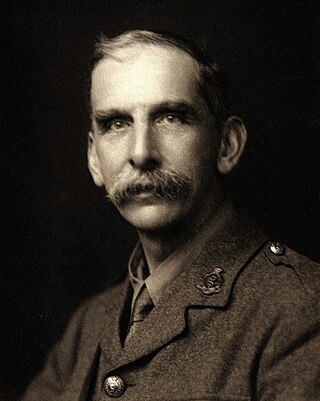
Heike Kamerlingh Onnes was a Dutch physicist. After studying in Groningen and Heidelberg he became professor of experimental physics at the University of Leiden where he taught from 1882 to 1923. In 1904 he established a cryogenics laboratory where he exploited the Hampson–Linde cycle to investigate how materials behave when cooled to nearly absolute zero. In 1908 he became the first to liquefy helium cooling it to near 1.5 Kelvin, at the time the coldest temperature achieved on earth. For this research he was awarded the Nobel Prize in Physics in 1913. Using liquid helium to investigate the electrical conductivity of solid mercury he found in 1911 that at 4.2 K its electrical resistance vanishes, thus discovering superconductivity.

William H. Spottiswoode HFRSE LLD was an English mathematician, physicist and partner in the printing and publishing firm Eyre & Spottiswoode. He was president of the Royal Society from 1878 to 1883.

Sir Charles Scott Sherrington was a British neurophysiologist. His experimental research established many aspects of contemporary neuroscience, including the concept of the spinal reflex as a system involving connected neurons, and the ways in which signal transmission between neurons can be potentiated or depotentiated. Sherrington himself coined the word "synapse" to define the connection between two neurons. His book The Integrative Action of the Nervous System (1906) is a synthesis of this work, in recognition of which he was awarded the Nobel Prize in Physiology or Medicine in 1932.

John Hughlings Jackson, FRS was an English neurologist. He is best known for his research on epilepsy.

Sir David Ferrier FRS was a pioneering Scottish neurologist and psychologist. Ferrier conducted experiments on the brains of animals such as monkeys and in 1881 became the first scientist to be prosecuted under the Cruelty to Animals Act, 1876 which had been enacted following a major public debate over vivisection.

Sir Victor Alexander Haden Horsley was a British scientist and professor.

Sir Colin Blakemore,, Hon was a British neurobiologist, specialising in vision and the development of the brain. He was Yeung Kin Man Professor of Neuroscience and senior fellow of the Hong Kong Institute for Advanced Study at City University of Hong Kong. He was a distinguished senior fellow in the Institute of Philosophy, School of Advanced Study, University of London and Emeritus Professor of Neuroscience at the University of Oxford and a past Chief Executive of the British Medical Research Council (MRC). He was best known to the public as a communicator of science but also as the target of a long-running animal rights campaign. According to The Observer, he was both "one of the most powerful scientists in the UK" and "a hate figure for the animal rights movement".

The Croonian Medal and Lecture is a prestigious award, a medal, and lecture given at the invitation of the Royal Society and the Royal College of Physicians.
From the ancient Egyptian mummifications to 18th-century scientific research on "globules" and neurons, there is evidence of neuroscience practice throughout the early periods of history. The early civilizations lacked adequate means to obtain knowledge about the human brain. Their assumptions about the inner workings of the mind, therefore, were not accurate. Early views on the function of the brain regarded it to be a form of "cranial stuffing" of sorts. In ancient Egypt, from the late Middle Kingdom onwards, in preparation for mummification, the brain was regularly removed, for it was the heart that was assumed to be the seat of intelligence. According to Herodotus, during the first step of mummification: "The most perfect practice is to extract as much of the brain as possible with an iron hook, and what the hook cannot reach is mixed with drugs." Over the next five thousand years, this view came to be reversed; the brain is now known to be the seat of intelligence, although colloquial variations of the former remain as in "memorizing something by heart".

Richard Caton, of Liverpool, England, was a British physician, physiologist and Lord Mayor of Liverpool who was crucial in discovering the electrical nature of the brain and laid the groundwork for Hans Berger to discover alpha wave activity in the human brain.
John Alfred Gotch was a noted English architect and architectural historian. His brother was the Pre-Raphaelite painter and illustrator Thomas Cooper Gotch, who painted his portrait. Married to Annie Gotch, one of their sons, Roby Myddleton Gotch was killed in action during the First World War aged 26.
Timothy Vivian Pelham Bliss FRS is a British neuroscientist. He is an adjunct professor at the University of Toronto, and a group leader emeritus at the Francis Crick Institute, London.
Mabel Purefoy FitzGerald was a British physiologist and clinical pathologist best known for her work on the physiology of respiration. She became the second female member of the American Physiological Society in 1913. She worked with many great scientists during her research like William Osler, John Scott Haldane, Charles Scott Sherrington, and many more in a plethora of fields like pathology, immunology, gastroenterology, respiratory physiology and neurobiology.Mabel published a total of eleven papers over her work.

John Graham Nicholls FRS was a British, American and Swiss physiologist and neuroscientist.

William Bulloch FRS was a British bacteriologist and historian of bacteriology.
John Smyth Macdonald FRS was a British physiologist.
Geoffrey Wingfield Harris (1913–1971) was a British physiologist and neuroendocrinologist. Often considered the "father of neuroendocrinology", he is best known for showing that the anterior pituitary is regulated by the hypothalamus via the hypophyseal portal system. His work established the principles for the 1977 Nobel Prize-winning discovery of hypothalamic hormones by Schally and Guillemin.

James Samuel Risien Russell was a Guyanese-British physician, neurologist, professor of medicine, and professor of medical jurisprudence.
Sir Edward Stanley Gotch Robinson, FBA (1887–1976), usually known as SirStanley Robinson, was a numismatist specializing in Greek and Roman coins. He served as Keeper of the Department of Coins and Medals at the British Museum.
Rosamund Brunel Gotch was an English stage costume designer, illustrator and writer.












